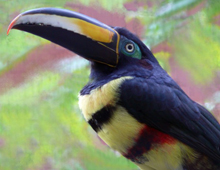Description: The head and throat of the male Many-banded aracari are black with a chestnut patch behind the eye. The yellow eyes are surrounded by blue skin. The large bills are black and yellow striped. The back and tail are dark green to almost black; the rump is red. Its undersides are yellow and as its name implies, it has a black band across its chest and a black-red band across its belly (only aracari so banded on chest and belly).
Size: One of the largest aracaris, it measures approximately 17 inches (44 cm) and weighs 8-11 ounces (230-300 gr).
Behavior: Aracaris live in flocks of several individuals. They roost socially, with adults and fledglings sharing the same tree cavity for sleeping.
Diet: Foraging singly, in pairs or small groups, their diet consists mainly of fruits, nuts and some arthropods.
Communication: Vocalizations are used for signaling aggression or contact. Not considered to be song-like, calls vary in length and emphasis. It is believed that similar species, make similar calls, varying by location. Calls of the Many-banded, Collared, Black-necked and Chestnut-eared aracaris are high, sharp and piercing.
Reproduction: Two to four white eggs are laid in a tree cavity, often an abandoned woodpecker’s nest. Both sexes incubate the eggs for a period of 16-17 days and both parents feed the chicks. Fledging occurs at approximately 40 days.
Habitat/range: They are found in South American forests of Colombia, southern Venezuela, Peru and northern Brazil
Status: Classified as Least Concern (LC) on IUCN Red List.



